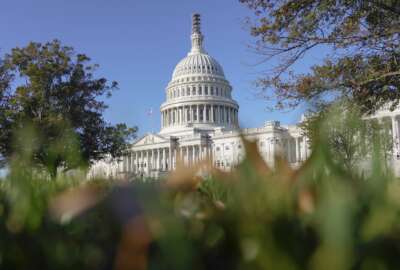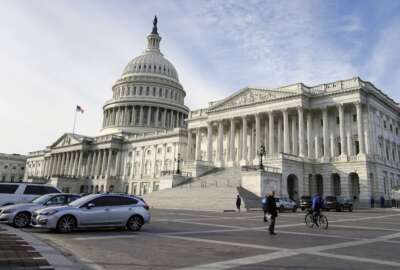Once again with feeling, Congress goes for a budget
Border. Budget. Border. Budget. If Congress sounds like a broken record, well it is. With two weeks to go before government funding lapses for many agencies,...
Border. Budget. Border. Budget. If Congress sounds like a broken record, well it is. With two weeks to go before government funding lapses for many agencies, Congress did something to move the ball forward on Sunday. The Federal Drive with Tom Temin gets the latest from Bloomberg Government deputy news director Loren Duggan.
Interview Transcript:
Tom Temin Well, it turns out Congress over the weekend looks like it may be made a little progress. We get the latest now from Bloomberg Government Deputy News director Loren Duggan. And Loren, what happened and what does it look like now? Never a dull moment, even on the weekends.
Loren Duggan Well, what had been eluding congressional leaders for weeks. Here is a top line spending deal that would allow appropriators to write the 12 spending bills that was announced yesterday by speaker Mike Johnson, Senate Majority Leader Chuck Schumer and lauded by the president, who had been waiting for this as well. This is all been about what did last summer’s debt limit deal mean for this year’s spending bills? And they basically have gone back to what the top line numbers written into law were, but then reached another agreement on what had been called a side deal that had been reached between then Speaker Kevin McCarthy and President Joe Biden about money that would be cut from elsewhere and used to offset spending. So we finally have that framework in place that will allow appropriators to do their work ahead of these key spending deadlines that are coming up.
Tom Temin So this top line deal, then, does that break down according to agency by agency, or are they that far yet?
Loren Duggan No. That’s what remains to be done. And there’s a lot of work there. As you know, they set two spending deadlines January 19th and February 2nd. Uh, February the 1st one coming up, January 19th, applies to four of the regular spending bills. So those are the bills that are going to be top of mind now as the operators figure out how much to spend in each of those four bills and then go department by department, agency by agency. And key to that still is going to be figuring out what policy writers make it in, because that could determine whether or not those bills can make it through both chambers.
Tom Temin Right. So the top line number though must have some rough idea behind there of agency by agency, because the 1.6 trillion, whatever it is, is based roughly on what the agency submitted or what the administration put in for its 2024 request.
Loren Duggan That’s right. And we saw Senate spending bills that were written closer to that number, although they had some emergency spending and other funding as well. So there could be a roadmap closer to that if you’re looking for $1.59 trillion. Um, part of this was also to agree on a defense and a non-defense number. Um, obviously, the defense number is pretty concordant to what’s in the defense spending bill, although there’s some programs that other spending measures as well. But, you know, the detailed level that’s going to take some time to work through, uh, because lawmakers have different priorities than the administration. And certainly conservatives in the House are going to want to put some mark on these bills and cut spending in some places and maybe reprioritize it elsewhere.
Tom Temin So does this deal then, or this a tentative deal? Take away the prospect of a long term continuing resolution. I mean, what what does it mean in terms of what they’re likely to do next in terms of full term, full year appropriations?
Loren Duggan Appropriators say they’re going to buckle down work day and night to try and get some spending bills done the first four by January 19th, the others by February 2nd. House Republicans have been reluctant to pass another short term CR, so I think they’ll be pushing to make that January 19th deadline. And then also we’ll we’ll see what else might take a ride with these packages as they come together. Words, whether it’s that border security deal that they’re trying to negotiate, the Ukraine, Israel, Taiwan and other supplemental funding or something like a tax deal, which, um, the House Ways and Means and Senate Finance committees are trying to put together.
Tom Temin But safe to say that the Ukraine and Israel aid that was more bound to the disagreement over the border than the budget was bound to disagreement over the border. That is to say, the budget could happen. The Supplementals are still hung up with politics and and disagreement over the border.
Loren Duggan That could be. And some House Republicans, after visiting the border last week, want to tie regular funding to that border border security legislation. But we’ll see if that dynamic plays out, or if this top line deal smooths the path for things to move, even if that’s not ready to go.
Tom Temin So we could see kind of a two phase process, one for the next couple of weeks and then one for the later February deadline. So a lot more to follow. Yet as the boys and girls on the hill learn to get along.
Loren Duggan Yes, there’s a long path ahead of us here before February 2nd, to be sure.
Copyright © 2025 Federal News Network. All rights reserved. This website is not intended for users located within the European Economic Area.
Tom Temin is host of the Federal Drive and has been providing insight on federal technology and management issues for more than 30 years.
Follow @tteminWFED






